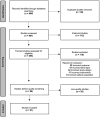Resting and TMS-EEG markers of treatment response in major depressive disorder: A systematic review
- PMID: 35992942
- PMCID: PMC9387384
- DOI: 10.3389/fnhum.2022.940759
Resting and TMS-EEG markers of treatment response in major depressive disorder: A systematic review
Abstract
Electroencephalography (EEG) is a non-invasive method to identify markers of treatment response in major depressive disorder (MDD). In this review, existing literature was assessed to determine how EEG markers change with different modalities of MDD treatments, and to synthesize the breadth of EEG markers used in conjunction with MDD treatments. PubMed and EMBASE were searched from 2000 to 2021 for studies reporting resting EEG (rEEG) and transcranial magnetic stimulation combined with EEG (TMS-EEG) measures in patients undergoing MDD treatments. The search yielded 966 articles, 204 underwent full-text screening, and 51 studies were included for a narrative synthesis of findings along with confidence in the evidence. In rEEG studies, non-linear quantitative algorithms such as theta cordance and theta current density show higher predictive value than traditional linear metrics. Although less abundant, TMS-EEG measures show promise for predictive markers of brain stimulation treatment response. Future focus on TMS-EEG measures may prove fruitful, given its ability to target cortical regions of interest related to MDD.
Keywords: TMS-EEG; antidepressant; biomarkers; electroencephalography (EEG); major depressive disorder (MDD); repetitive transcranial magnetic stimulation (rTMS); transcranial magnetic stimulation (TMS); treatment.
Copyright © 2022 Strafella, Chen, Rajji, Blumberger and Voineskos.
Figures
Similar articles
-
Use of machine learning in predicting clinical response to transcranial magnetic stimulation in comorbid posttraumatic stress disorder and major depression: A resting state electroencephalography study.J Affect Disord. 2019 Jun 1;252:47-54. doi: 10.1016/j.jad.2019.03.077. Epub 2019 Mar 30. J Affect Disord. 2019. PMID: 30978624 Free PMC article. Clinical Trial.
-
Altered Transcranial Magnetic Stimulation-Electroencephalographic Markers of Inhibition and Excitation in the Dorsolateral Prefrontal Cortex in Major Depressive Disorder.Biol Psychiatry. 2019 Mar 15;85(6):477-486. doi: 10.1016/j.biopsych.2018.09.032. Epub 2018 Oct 18. Biol Psychiatry. 2019. PMID: 30503506 Clinical Trial.
-
Brain oscillation-synchronized stimulation of the left dorsolateral prefrontal cortex in depression using real-time EEG-triggered TMS.Brain Stimul. 2020 Jan-Feb;13(1):197-205. doi: 10.1016/j.brs.2019.10.007. Epub 2019 Oct 12. Brain Stimul. 2020. PMID: 31631058 Clinical Trial.
-
Use of transcranial magnetic stimulation (TMS) for studying cognitive control in depressed patients: A systematic review.Cogn Affect Behav Neurosci. 2024 Dec;24(6):972-1007. doi: 10.3758/s13415-024-01193-w. Epub 2024 May 21. Cogn Affect Behav Neurosci. 2024. PMID: 38773020 Free PMC article.
-
Toward the establishment of neurophysiological indicators for neuropsychiatric disorders using transcranial magnetic stimulation-evoked potentials: A systematic review.Psychiatry Clin Neurosci. 2020 Jan;74(1):12-34. doi: 10.1111/pcn.12936. Epub 2019 Nov 2. Psychiatry Clin Neurosci. 2020. PMID: 31587446
Cited by
-
Neural Electrical Correlates of Subjective Happiness.Hum Brain Mapp. 2025 Jun 1;46(8):e70224. doi: 10.1002/hbm.70224. Hum Brain Mapp. 2025. PMID: 40421899 Free PMC article.
-
Exploring the potential of combining transcranial magnetic stimulation and electroencephalography to investigate mild cognitive impairment and Alzheimer's disease: a systematic review.Geroscience. 2024 Aug;46(4):3659-3693. doi: 10.1007/s11357-024-01075-6. Epub 2024 Feb 15. Geroscience. 2024. PMID: 38356029 Free PMC article.
References
-
- Abhang P. A., Gawali B. W., Mehrotra S. C. (2016). Introduction to EEG-and Speech-Based Emotion Recognition. Academic Press.
-
- Aftanas L. I., Varlamov A. A., Pavlov S. V., Makhnev V. P., Reva N. V. (2002). Time-dependent cortical asymmetries induced by emotional arousal: EEG analysis of event-related synchronization and desynchronization in individually defined frequency bands. Int. J. Psychophysiol. 44, 67–82. 10.1016/S0167-8760(01)00194-5 - DOI - PubMed
-
- Alexander M. L., Alagapan S., Lugo C. E., Mellin J. M., Lustenberger C., Rubinow D. R., et al. . (2019). Double-blind, randomized pilot clinical trial targeting alpha oscillations with transcranial alternating current stimulation (tACS) for the treatment of major depressive disorder (MDD). Transl. Psychiatry 9, 1–12. 10.1038/s41398-019-0439-0 - DOI - PMC - PubMed
-
- Almeida Montes L. G., Prado Alcántara H., Portillo Cedeño B. A., Hernández García A. O., Fuentes Rojas P. E. (2015). Persistent decrease in alpha current density in fully remitted subjects with major depressive disorder treated with fluoxetine: a prospective electric tomography study. Int. J. Psychophysiol. 96, 191–200. 10.1016/j.ijpsycho.2015.03.010 - DOI - PubMed
Publication types
LinkOut - more resources
Full Text Sources


